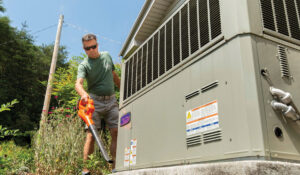We’re more energy efficient than you might think, and we can do even better with a little innovative thinking. Electricity touches our lives nearly every minute of every day and makes up about 5% of the nation’s Gross Domestic Product (GDP). So, it makes sense to use it wisely, whether you’re concerned about how it affects the environment and/or you want to save money.
Here are three surprising facts about energy efficiency that can help you make the best use of
your electricity.
Proof of efficiency
A little-known way of measuring efficiency is with a statistic called the energy intensity index. It shows how much energy it takes to produce a dollar of the economy’s GDP. Another term used for that idea is energy productivity.
The indexes show that we’re getting better at creating more economic activity with less energy — energy intensity is down, and productivity is up. Way up.
The numbers show that energy intensity is about half of what it was 30 years ago. That’s because we’re making strides in a range of ways, from building codes to light bulbs and vehicle mileage. These improvements are expected to continue. The Department of Energy projects energy intensity will decline by 30% over the next 30 years.
Out with the old, in with the new
The old phrase “you have to spend money to make money” is catchy because at first, it sounds like it doesn’t make sense. But when it comes to appliances that consume a lot of energy, it can make dollars and sense.
From dishwashers to computers, energy efficiency is improving every year as technology, federal rules and competition give you a better bang for your buck. In fact, if your refrigerator or dishwasher is more than 10 years old, a new appliance could pay for itself in just a few years with the money saved on energy use.
The yellow Energy Guide labels found on products at your appliance store will tell you how much you can save with a new purchase. Another way to compare the old to the new is to Google “flip your fridge.” That takes you to an ENERGY STAR calculator that compares the energy use of your current appliances to what’s available in stores.
Slaying vampires
Did you know you could be spending $100 to $400 a year on energy you don’t need? That frightening fact even comes with scary names — phantom power or vampire electronics. It’s the TV and video games that draw power so they’re ready to turn on instantly. It’s the digital clocks. It’s the computers and phones plugged in even though they’re fully charged.
Getting rid of phantom power can be tricky. You may not want to regularly shut off your wireless router or constantly reboot your smart TV, but you can plug several devices into a power strip and turn them off with one switch when they’re not in use.
When shopping for new electronics and appliances, look for the latest ENERGY STAR-rated models that take vampire loads into account. To start exorcising the phantoms, take a notepad through each room of your home to list anything plugged in, so you can figure out which energy users you might be able to control without causing much inconvenience.
Phantom power costs add up, but your home has much bigger energy users. If you’re concerned about energy costs, make sure your heating and cooling system is up to date and working efficiently, and that your windows and doors aren’t leaking air.
Your electric co-op can advise you on the most effective steps for energy savings — they’re your local leading authority on home energy use. And that’s no surprise.
Phantom power is energy consumed by electronics and appliances when they’re in standby mode but not being used. Phantom power costs typically range from $100 to $400 annually. Photo courtesy of Louis Poitras.










